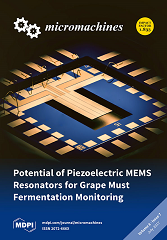Open AccessFeature PaperArticle
Potential of Piezoelectric MEMS Resonators for Grape Must Fermentation Monitoring
by
Georg Pfusterschmied, Javier Toledo, Martin Kucera, Wolfgang Steindl, Stefan Zemann, Víctor Ruiz-Díez, Michael Schneider, Achim Bittner, Jose Luis Sanchez-Rojas and Ulrich Schmid
Cited by 21 | Viewed by 6035
Abstract
In this study grape must fermentation is monitored using a self-actuating/self-sensing piezoelectric micro-electromechanical system (MEMS) resonator. The sensor element is excited in an advanced roof tile-shaped vibration mode, which ensures high
Q-factors in liquids (i.e.,
Q ~100 in isopropanol), precise resonance frequency
[...] Read more.
In this study grape must fermentation is monitored using a self-actuating/self-sensing piezoelectric micro-electromechanical system (MEMS) resonator. The sensor element is excited in an advanced roof tile-shaped vibration mode, which ensures high
Q-factors in liquids (i.e.,
Q ~100 in isopropanol), precise resonance frequency analysis, and a fast measurement procedure. Two sets of artificial model solutions are prepared, representing an ordinary and a stuck/sluggish wine fermentation process. The precision and reusability of the sensor are shown using repetitive measurements (10 times), resulting in standard deviations of the measured resonance frequencies of ~0.1%,
Q-factor of ~11%, and an electrical conductance peak height of ~12%, respectively. With the applied evaluation procedure, moderate standard deviations of ~1.1% with respect to density values are achieved. Based on these results, the presented sensor concept is capable to distinguish between ordinary and stuck wine fermentation, where the evolution of the wine density associated with the decrease in sugar and the increase in ethanol concentrations during fermentation processes causes a steady increase in the resonance frequency for an ordinary fermentation. Finally, the first test measurements in real grape must are presented, showing a similar trend in the resonance frequency compared to the results of an artificial solutions, thus proving that the presented sensor concept is a reliable and reusable platform for grape must fermentation monitoring.
Full article
►▼
Show Figures






